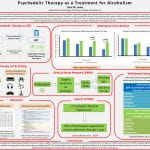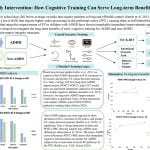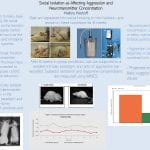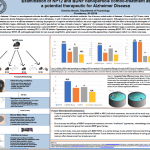Experimental Biopsychology
These student projects were part of Dr. Victoria Templer’s PSY426: Experimental Biopsychology class.
The Involvement of PTSD Arousal Symptoms in Declarative and Non-Declarative Memory
Carina Alessandro ’21
Majors: Biology and Psychology
Faculty Mentor: Dr. Victoria Templer, Psychology
Post-traumatic stress disorder (PTSD) is a debilitating disorder that is associated with pervasive anxiety-like arousal symptoms that result from the over-activation of the body’s stress response. In human studies, there is evidence showing that the presence of anxiety-like arousal symptoms may play a role in declarative memory (DM) and non-declarative memory (NDM) deficits. Rodent studies fail to investigate the effects of anxiety-like arousal symptoms on multiple forms of memory due to difficulties in creating a model of PTSD that encapsulates the complexities of the human disorder and an absence of tasks that effectively measure both DM and NDM. This study investigated the effects of anxiety-like arousal symptoms of PTSD-like rats on their performance in DM and NDM tasks. Single prolonged stress (SPS), which involves a threefold exposure to stressors, was used to model PTSD in 22 male Long-Evans rats, with 22 healthy controls receiving no exposure to stress. Based on their exploratory behavior on the elevated plus maze, results indicated that PTSD-like rats have higher levels of anxious-like behaviors than the healthy controls. Additionally, PTSD-like rats performed poorer on both DM (i.e., allocentric object recognition) and NDM (i.e., fixed-ratio reinforcement operant conditioning) tasks, suggesting an involvement of PTSD anxiety-like arousal symptoms in DM and NDM impairments.
Psychedelic Therapy as a Treatment for Alcoholism
Trina Lewis ’21
Majors: Psychology
Faculty Mentor: Dr. Victoria Templer, Psychology
Psychedelic therapy is a seldom studied, but promising treatment for substance abuse disorder. A previous study assessed the success of psychedelic therapy in treating alcoholism, with encouraging results (Garcia-Romeu et al.,). We will also study psychedelic therapy as a treatment for alcoholism, with the addition of a comparative control group who will undergo cognitive behavior therapy (CBT), a common treatment for alcoholism. This experiment will examine 62 participants, male and female, who suffer from alcoholism between the ages of 21 and 65, with 31 participants in each group. The control group will undergo CBT with one of two therapists who specialize in addiction treatment for one hour, once a week, for four weeks. The experimental group will also undergo CBT with the same therapists for one hour, once a week, for four weeks, with each session followed by a psychedelic trip induced by a standard (20mg/70kg) dose of psilocybin. Both the control group and the experimental group will take the Alcohol Abstinence Self-Efficacy Scale before beginning therapy, directly after their final session, and at 3 months, 6 months, and one year after their final session. The experimental group will additionally take a Mystical Experience Questionnaire (MEQ) following each of their trips. We predict that the experimental group will have a significantly higher number of participants remain abstinent from alcohol with fewer and less severe withdrawal symptoms in comparison to the control group. We also predict that a significant percentage of the experimental group who remained abstinent through one year will have had at least two complete mystical experiences. The goal of this experiment is to improve the validity of psychedelic therapy as an effective treatment for alcoholism, as well as addiction in general.
Executive Functioning Early Intervention: How Cognitive Training Can Serve Long-term Benefits for Children with ADHD
Sarah Travers ’22
Majors: Biology and Psychology
Faculty Mentor: Dr. Victoria Templer, Psychology
Children diagnosed with ADHD in their early school days fall below average on tasks that require problem solving and effortful-control. These children lack control of their executive functioning (EF), a set of skills that require higher-order processing in the prefrontal cortex (PFC), causing them to fall behind their peers in school (Rueda et al. 2012; Zelazo 2020). Cognitive training programs that target the improvement of EF in children with ADHD have shown remarkable immediate improvements upon academic and behavioral measures, but have failed to examine their long-term implications (Kofler et al. 2018; Rueda et al. 2012). This research investigates the long-term benefits of early cognitive training (CET) for ADHD and non-ADHD children upon academic (IQ), behavioral (ANT), and white matter integrity (DTI) measures. If cognitive training has long-term benefits for children with ADHD their change in task scores will match their non-ADHD counterparts. However, if cognitive training does not have long-term benefits for children with ADHD, their change in task scores will subsequently show smaller improvements upon 10 year post evaluation. It is expected that early cognitive experiences will change behavior to allow for the installment of long-lasting connections. The earlier these connections can be made, the earlier children with ADHD can improve upon and master their EF.
Effects of 3,4-Methamphetamine on Cognitive Empathy in Participants with Antisocial Personality Disorder
Emily Bosiacki ’21
Majors: Biology and Psychology
Faculty Mentor: Dr. Victoria Templer, Psychology
3,4-Methamphetamine (METH) has not been studied as a treatment method for people who have Antisocial Personality Disorder (ASPD). ASPD is mainly characterized by a lack of cognitive and emotional empathy. Previous research expresses that emotional empathy is achievable through drug treatment with empathogens such as ecstacy and psilocybin, but there has been no successful treatment to improve cognitive empathy. METH has not been used in previous research due it being very addictive and detrimental to cognitive function if taken at high levels over an extended period of time. Microdosing METH shows promising results in patients with attention deficit hyperactivity disorder (ADHD). Using this previous research to understand effective dosing and symptoms of microdosing METH, a promising treatment could be established for ASPD participants. For patients taking METH, users report having higher levels of sociability. With an increase in sociability, it is hypothesized that there will be an increase in cognitive empathy as well. This will be tested through the use of the Multifaceted Empathy Test (MET) which specifically measures cognitive empathy, and the Empathy Quotient (EQ) which analyzes both emotional empathy and cognitive empathy. It is hypothesized that during pre-treatment, participants in the treatment group receiving METH, will show an average score for the EQ and report emotions of others at least 50% correctly for the MET, while the control group will continue to score below average for their EQ and will report emotions of others below 50% correctly for the MET.
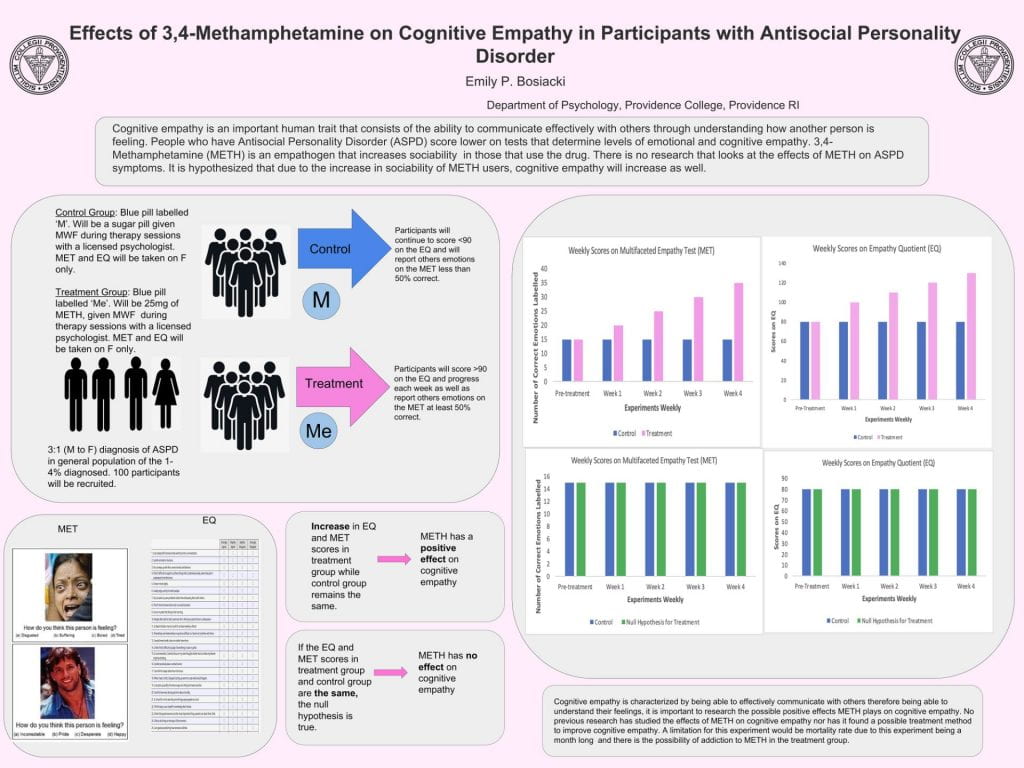
Can altering the gut microbiome via diet treat symptoms of major depressive disorder?
Julia DeGrooth ’21
Majors: Biology and Psychology
Faculty Mentor: Dr. Victoria Templer, Psychology
Due to the prevalence of Major Depression worldwide, researchers have begun to search for alternative treatment methods other than antidepressants. Previous studies have shown that depression is affected by the gut microbiota, but the actual composition of the gut in Major Depressive Disorder (MDD) is not well understood. Here, I analyzed fecal samples of 100 participants with MDD and 100 healthy controls. One hundred people from the control and experiment groups were randomly and equally assigned to either a Mediterranean diet or a Western diet. According to previous research, fecal samples showed increased fecal diversity in MDD and Mediterranean diet group compared to the control groups (Western diet and healthy participants and Western diet and MDD). Increased levels of Bacteroidetes and Proteobacteria in the experimental group decreased the severity of depression according to the significant drop in PHQ-9 score. However, a high level of Lactobacillus and Firmicutes correlated to increased severity of MDD symptoms in the control group. The gut microbiome of the healthy control group did not improve their behavior or change their bacterial composition. These possible findings help understand predominant bacteria in the gut that are harmful and beneficial to MDD patients. Further studies need to investigate a causal relationship between the gut microbiome and major depression.
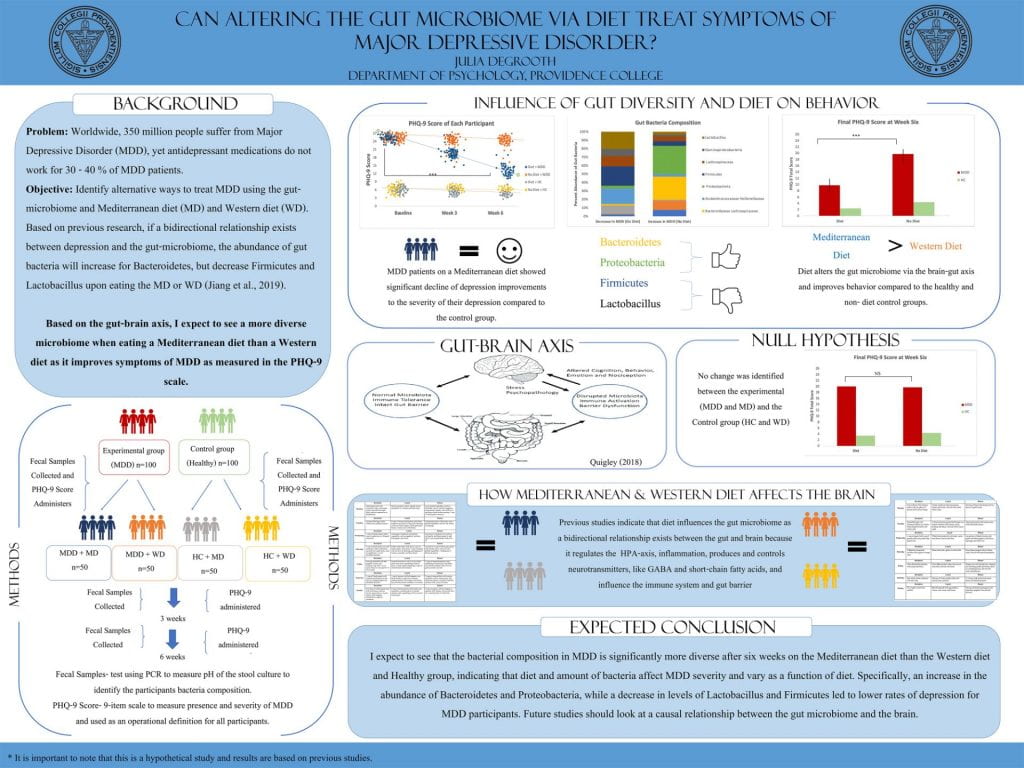
The Influence of Polyvagal Theory on Emotion Recognition in Bipolar Disorder
Samantha Sierra ’22
Majors: Biology and Psychology
Faculty Mentor: Dr. Victoria Templer, Psychology
Previous studies have found a relationship between people with bipolar disorder and having increased difficulty in identifying emotions. A current study investigates whether the polyvagal theory can explain why patients with bipolar disorder have difficulty identifying emotions. We evaluated people with bipolar disorder and a control group who do not have bipolar disorder, they then were placed within two groups. Group one participants watched a stimulus triggering video, while group two watched a neutral video. Their heartrate was monitored. They then performed an identifying emotion task and a social interaction task. The hypothesis states people with bipolar 1 disorder who are not actively experiencing a manic or depressive episode when presented with a negative stimulus will score worse on an identifying emotion task and social interaction task than those who are not presented with the stimulus. The identifying emotion task was identifying 30 faces. The social interaction task contained 12 questions. The results showed BD groups one and two scored lower than the control in the identifying emotion task and the social interaction task. BD participants also had higher autonomic arousal than the control in both groups.
Can Short-Term Diet Change Enhance your Immunological Health?
Maxwell Sinoway ’22
Majors: Biology and Psychology
Faculty Mentor: Dr. Victoria Templer, Psychology
Psychoneuroimmunology is the study of the effect of the mind on health and resistance to disease. In respect to Psychoneuroimmunology, psychological health and biological health can be enhanced or hurt by diet. Diet drives how well our body can work physically, but this physical enhancement or demise directly effects your psychological health as well. These effects compound with each other and can be extremely helpful or extremely hurtful to your overall immunological health. Long term diet research has been done before but none of which explores the effects of short-term diet change on both biological and psychological markers of immune system health. In this experiment, psychological markers of health and biological markers of health were examined over two short-term diets of two weeks. These diets included one which was considered a healthy diet and one that was considered a high fat diet. Self-perception, happiness, weight, WBC/T-Killer Cell count, and Immunoglobulin A concentration were our markers for immunological health. Subjects were evaluated by these psychological and biological markers before and after their two-week diet and then the evaluations were compared. Subjects who fell into the healthy diet group performed better than those in the high fat diet group in every category. This shows that even short-term exposure to a healthy diet can positively impact your immunological health both biologically and psychologically
Early Life Socialization as Impacting Neurotransmitter Concentration and Aggression
Mallory Peishoff ’22
Majors: Psychology
Faculty Mentor: Dr. Victoria Templer, Psychology
The study of aggression is a widely encompassing and highly applicable area of psychology, with a wide range of involved fields. To develop an understanding of the applications of aggression analysis, its causes must be established. The goal of this study was to develop an understanding of early life socialization as it affects behavioral expressions of aggression, as well as its impact on neurotransmitter concentration. Through a rat model, assigned groups of isolated and socialized rats were subjected to a resident-intruder paradigm. Screening for acts of aggression through the paradigm provided significant indicators that social deprivation at a young age causes an increase in aggression later in life. Wireless Instantaneous Neurotransmitter Concentration systems (WINCS) was applied to measure serotonin and dopamine concentration within subjects. Rats presented with a significantly decreased neurotransmitter concentration in comparison to control baseline results. Combining understanding of the two fronts, evidence suggests that social isolation in early life leads to heightened aggression and deficient neurotransmitter levels in adulthood.
Examination of NP12 and BDNF nanoparticle combo-treatment as a potential therapeutic for Alzheimer Disease
Dominic Arruda ’22
Majors: Psychology
Faculty Mentor: Dr. Victoria Templer, Psychology
Alzheimer’s Disease is a neurodegenerative disorder that afflicts approximately 44 million individuals worldwide. Although previous research has shown that BDNF therapeutics may serve as an efficient treatment for reducing the progression of cognitive and behavioral deficits, the results suggest that such methods had little effect in decreasing the development of neurofibrillary tangles. To address previous safety and efficacy limitations in the current study, Tg2676 mice were treated with nanoparticles containing BDNF, NP12 (a GSK 3B inhibitor), BDNF and NP12 (combo treatment), or no treatment. Nanoparticles were injected prior to the onset of spatial memory deficits to assess whether treatment may lead to a delay in symptom onset and severity. BDNF, AB, and hyperphosphorylated tau were assessed using ELISA; spatial memory was assessed around the expected time of spatial memory deficit via a Morris water maze.
Hippocampal Volume and Working Memory Deficits in Generalized Epilepsy Compared to Temporal Lobe Epilepsy
Sarah Bica ’22
Majors: Psychology
Faculty Mentor: Dr. Victoria Templer, Psychology
Previous research suggests that temporal lobe epilepsy (TLE), a type of focal epilepsy, is associated with smaller hippocampal (HPC) volume and lower working memory (WM) performance compared to control groups (Postma et al., 2017). Other research found that generalized tonic-clonic seizures (sGTCS) induced by TLE is associated with smaller HPC volume than non-sGTCS (Chen et al., 2019). However, a longitudinal study comparing HPC volume and WM performance between TLE and generalized tonic-clonic epilepsy (GTCE) has yet been done. This study recruited 75 participants at the age of fifteen who had diagnoses of TLE, GTCE, or no epileptic condition. Participants’ HPC volume was recorded using MRI. All participants were then assessed by the Working Memory Test Battery (Ma et al., 2017) using the visuospatial sketchpad subtest and the phonological loop subtest to record visual and verbal WM. Participant’s HPC volume and WM test performance was measured again at the age of thirty to analyze the long-term effects of their epileptic condition compared to the control group. Expected results for HPC volume show a decrease for both epileptic groups compared to the control. GTCE is expected to have smaller HPC volume than TLE at age of thirty. WM is also expected to decline in both epileptic conditions for both visual and verbal subtasks. However, GTCE is expected to show lower WM scores at age 30 as compared to TLE at age 30. GTCE is expected to display greater long-term effects on WM and HPC volume. These results are important because they provide insight for possible treatments for epileptic patients who suffer from WM deficits.
Use of Stem Cells for Treatment after Traumatic Brain Injury
Shanna King ’21
Majors: Biology, Neuroscience
Faculty Mentor: Dr. Victoria Templer, Psychology
Recent exploration of neural stem cell (NSC) treatment for traumatic brain injury (TBI) has shown promising recovery of cognitive and motor function. The most successful methods of treatment include VEGF and cerebrolysin injections and BDNF and hADSC grafts. This study examined the effectiveness of these treatments on recovery of cognitive and motor function. Fischer 344 male rats (N=20) were subjected to either TBI by closed cortical impact (n=16) or surgery with no TBI (n=4). 72 hours after injury, all rats were anesthetized again and were injected or transplanted with their treatment. All rats completed the Morris Water Maze (MWM) to measure cognitive, spatial function and the paw-grip task to measure motor, nonspatial function. At the baseline, all TBI rats showed significant deficit in cognitive and motor function. Beginning at 30 days after stem cell treatment, improvement on both tasks was seen. After 90 days, hADSC graft and VEGF injected rats showed significant improvement on both tasks, almost completely recovering to control levels. This suggests that both endogenous and exogenous methods of stem cell treatment are successful. This offers an exciting method of improving neural functioning after brain injuries, which currently have very limited treatment options.
Does Methamphetamine (MA) Cause Cognitive and Neurological Deficits? An Ecologically Valid Approach
Claire Stover ’21
Majors: Psychology
Faculty Mentor: Dr. Victoria Templer, Psychology
Methamphetamine Use Disorder (MUD), which is believed to cause cognitive and neurological deficits, is a growing public health concern in the United States. However, current animal constructs of MUD do not model human use patterns. MA users ramp up to a dosage of ~0.75 mg/kg, but current animal models utilize dosages of 3-15 mg/kg. Observed cognitive and neurological deficits may be caused by neurotoxic dosages of MA, not MA use itself. To test this hypothesis, mice were injected with MA twice/day, five days/week, for six months. Dosage increased over the first month to the maintenance dose of 0.75 mg/kg. Mice were administered a cognitive pre- and post-test examining one of four cognitive functions believed to be impaired by MA abuse: cognitive flexibility (set-shift/rule reversal task), decision making (delay discounting task), long-term memory (novel object recognition task), and social cognition (social preference/social novelty task). After completion of the post-test, mice were sacrificed for immediate early gene (IEG) analysis of the caudate nucleus and nucleus accumbens, two striatal regions believed to be damaged by MA abuse. We found a small yet significant decline in IEG expression in the nucleus accumbens and caudate nucleus for nearly all conditions, a significant increase in perseverance errors in the set-shift/rule reversal task, and a significant preference for immediate rewards in the delay discounting task. All other results were insignificant. This indicates that human MA use patterns do not cause global cognitive deficits, and that other brain regions can compensate for minor striatal deficits.

Effect of neurosteroid levels, genetic linkages, and pre-deployment virtualreality resilience training on PTSD severity
Kat Fama ’21
Majors: Biology
Faculty Mentor: Dr. Victoria Templer, Psychology
Though Post-Traumatic Stress Disorder (PTSD) is a common problem among soldiers, current military programs focus on treating PTSD after combat deployment instead of preventing it. The aim of this project was to examine the neurosteroids allopregnanolone and pregnanolone (together known as ALLO), the SNP rs717947, and pre-deployment virtual-reality resilience training (VRRT) to identify effective PTSD prevention methods. Pre-deployment, a Brigade Combat Team (N=3000) of active-duty US Army soldiers was divided into two groups, a VRRT group and an online tactical training sessions (control) group. Soldiers’ blood plasma levels of ALLO were also measured and their DNA was analyzed for the SNP. They then took the PTSD Checklist for the DSM-V (PCL-5) to measure PTSD symptom severity at baseline. Post-deployment, soldiers took the PCL-5 again to monitor for changes in PTSD symptom severity. This measure was repeated at 1-month, 3-months, and 6-months post-deployment. We found that VRRT led to no change in PCL-5 score, indicating that it successfully mitigated PTSD severity. Further, high ALLO levels protected against PTSD vulnerability. Combined, these two factors prevented against the development of severe PTSD. The presence of the SNP rs717947 increased vulnerability to PTSD, leading to more severe cases of the disorder. Overall, these findings provide support for both biological and psychological prevention methods for PTSD, which can be administered in the future to decrease PTSD prevalence in the military and beyond.
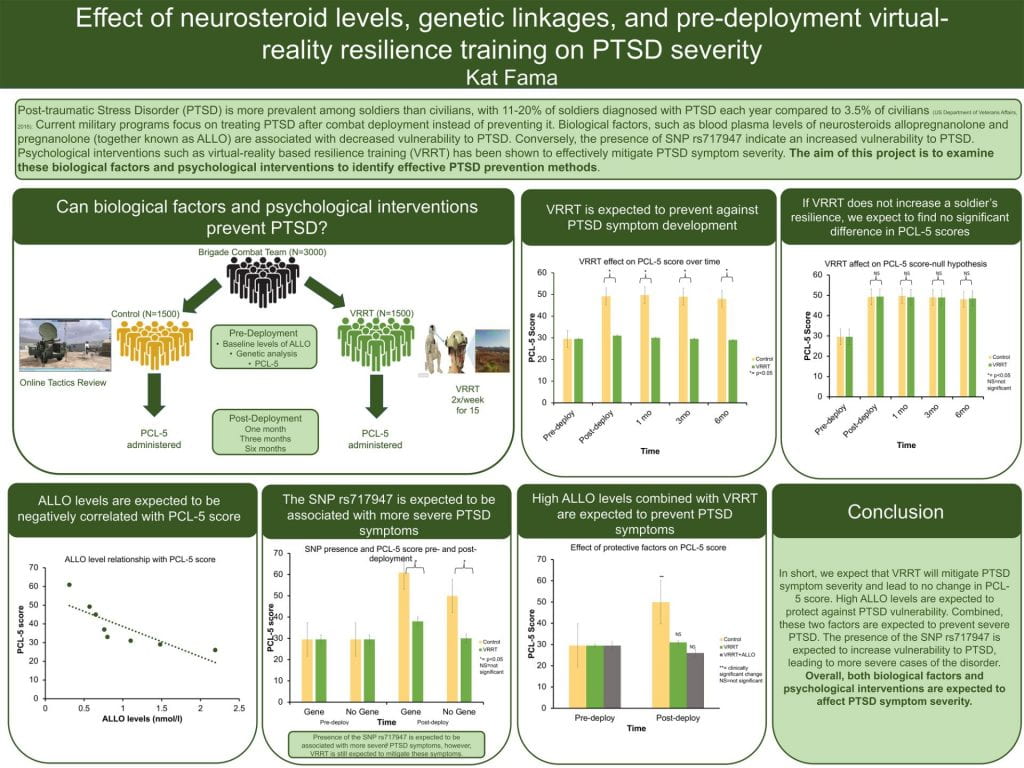
Do probiotics maintain gut microbiome equilibrium and provide mental health protection during circadian misalignment in shift workers?
Hanna Johnston ’21
Majors: Psychology and Health Policy and Management
Faculty Mentor: Dr. Victoria Templer, Psychology
Shift workers are at higher risk for depression, anxiety, and other mood disorders as a result of circadian misalignment. One of the mechanisms behind this is the gut microbiome that is responsible for the comorbidity between insomnia and depression due to the metabolism of microbes that produces neurotransmitters such as GABA, dopamine, melatonin, and serotonin.There have been studies examining the use of probiotics as an alternative treatment mechanism for depression and anxiety by restoring gut microbiome equilibrium; however, there are no studies evaluating the use of probiotics to protect against developing symptoms of these mental health disorders and their later progression. This study seeks to determine if the use of probiotics prior to circadian rhythm disturbances can act as a protective factor against the development of depression and anxiety symptoms brought on by circadian misalignment by maintaining gut microbiome equilibrium. Eighty nurses will be recruited prior to starting their work and grouped into rotating shift (RS) and day shift (DS) conditions based on their assigned schedules. Both RS and DS groups will be assigned to placebo or probiotic treatment groups. Baseline anxiety and depression scores, as well as gut microbiome composition, will be monitored for the duration of the study to evaluate changes in response to daily probiotic consumption one week before nurses begin shift working. If nurses in the RS probiotic condition exhibit lower levels of depression and anxiety for the duration of the study compared to the RS placebo condition, this will suggest that probiotics are effective at preventing mental health disorders from circadian misalignment. Furthermore, it suggests that probiotics could be recommended for use in shift workers to mitigate mental health disorders before their onset. Further studies will be required to evaluate whether or not the benefits of probiotic consumption outweigh the risks.








